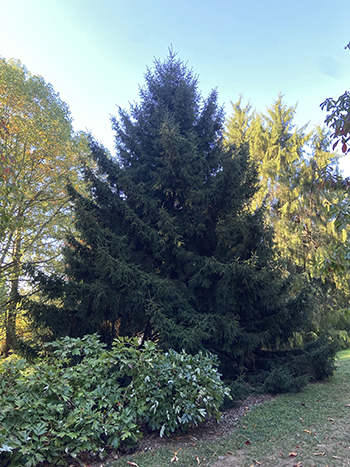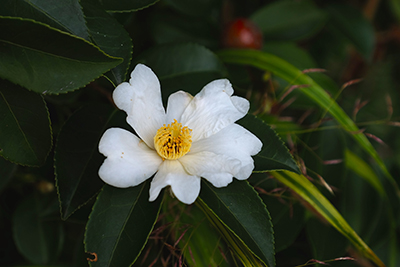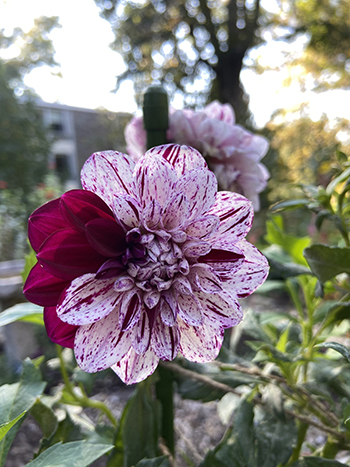
Plants of the Week: October 7

Picea orientalis ‘Gowdy’ (oriental spruce)
As the days start getting shorter and many trees begin to let go of their leaves, one begins to notice the plants that are left unchanged. Our heroes for year-round interest, evergreens are critical for creating garden spaces that can delight throughout the year. One such tree that has been catching my eye is the Picea orientalis ‘Gowdy’, who is sitting handsomely in the Tree Peony Collection.
Native to mountainous areas from the Caucasus to Turkey, this medium-to-large oriental spruce is densely branched and grows in a narrow-pyramidal habit. The needles of the P. orientalis and the shortest of any spruce, which is nicely demonstrated on the ‘Gowdy’ cultivar, whose very short, glossy, dark green needles are held close to the stem creating a lovely sweeping effect with the branches. The Scott Arboretum specimen in the Tree Peony collection was planted in 1992 and is a fantastic example of an oriental spruce, deep color, uniform in shape, and appealing in the garden landscape. photo credit: M. Rossman

Camellia oleifera ‘Lu Shan Snow’ (tea oil camellia)
It’s a joy really, to be able to look out into the garden, see certain plants, and not only appreciate them for their beauty and ecological services, but also for their stories. And it seems whenever I pick a camellia cultivar to highlight and begin to do my research, I am often able to find an in-depth documentation of how the cultivar came to be. Occasionally, cultivars from other genus will have a story, but none so thorough as those in the camellia world. With that, the Camellia oleifera ‘Lu Shan Snow’ has started to bloom in the Terry Shane Teaching Garden and I wish to share with you how this specific camellia came from China to now reside in our gardens.
When discussing camellias and their development within the United States, one cannot help but mention the U.S. National Arboretum in Washington D.C. which helped facilitate many of the camellia hybrids, trials, and introductions. Many of the cultivars introduced by the U.S. National Arboretum were aimed towards the goal of creating a more cold tolerant camellia. Some of the notable cultivars include those in the Winter Series (Ackerman Hybrids) such as Camellia ‘Snow Flurry’ and C. ‘Winter’s Snowman’ as well as the highlighted specimen for today’s post C. oleifera ‘Lu Shan Snow’.
The U.S. National Arboretum received seed of the C. oleifera from the Lu Shan Botanic Garden in China and was planted in their camellia collection 1949. The seedling fatefully withstood the bitterly cold winters in the late 1970s and was recognized by Dr. Willian Ackerman as a potential genetic source for cold tolerance. The cultivar ‘Lu Shan Snow’ was named in 1991 and released in 1995. The exceptionally hardy, fall blooming tea oil camellia can tolerate temperatures as low as -10 degrees fahrenheit. photo credit: D. Mattis

Dahlia ‘Hulin’s Carnival’ – (dahlia – formal decorative)
The summer perennials and annuals are starting to fade, but the dahlias are still in their prime! One of my favorite dahlias, recently added to the collection, is a variegated party of color, Dahlia ‘Hulin’s Carnival’. Introduced in 1954, this four inch wide bloom, may be a bit smaller, but does not miss a beat for impact in the garden. Blooms are a shining white with splashes of wine purple, with the occasional all white flower or solid purple flower. One dahlia website (Heron’s Nest Dahlias) provided this interpretation, “Cultivating the Hulin’s Carnival dahlia in your garden is to invite a perpetual celebration, to create a nook of revelry and color that defies the ordinary, turning every day into a festival of the senses.” photo credit: M. Rossman





No Comments